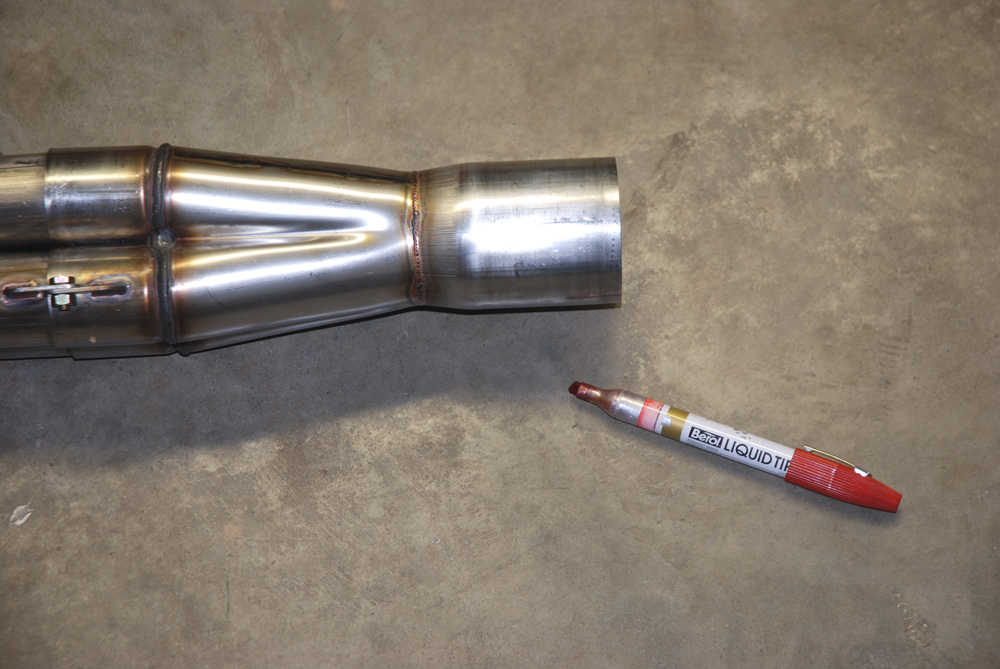
Drag Race 101: Headers, Part IV
Recall a few posts back, when we mentioned formulas and software that can help to figure out header dimensions? We’ll, we’re bringing you a couple of header formulas below and if you need to check out a neat software program that can do much of ground work for you, try pointing your browser to: http://www.maxracesoftware.com/PIPE395.htm.
When it comes to the formulas below, no real absolutes exist. On the other hand, the pipe dimensions that result from the math should help to put your project on the right track. You’ll also discover that the header primary tube diameter and length are interrelated. That means if you “lengthen” the tube size, it has an effect upon the tube diameter.
For our same test, we already knew that the maximum engine displacement was 402 cubic inches and the motor has a maximum speed limit of 7000 rpm. We guessed a primary tube length of 30.00 inches to get the ball rolling. Here’s the math.
Header Primary Tube Size
The equation is: Diameter = √((cubic inch displacement ×1900)/(tube length x rpm))
Let’s plug in our numbers:
Diameter = √((402 ×X1900)/(30 x × 7000))
Diameter = √((763,800)/(210,000)) = √ 3.6371428 = 1.9071294 inches or
2.00″ rounded off to the next largest available tube size
Length = Cubic inch displacement X 1900/2 x diameter x RPM
= 402 × 1900/2 × 2 × 7000 = 763,800/28,000 = 27.278571 inches
or 27.25 inches (rounded off to the closest available size)
In the event that the primary tube diameter had been rounded off to 1-7/8 inches or 1.875 inches, the basic formula would have worked out to the following:
= 402 × 1900/ 2 × 1.875 × 7000 = 763,800/ 26,250 = 29.097142 inches, or rounded off to 29 inches.
Collector Length
By varying the length of the header collector, you can also adjust the basic power band of the engine. If your combination needs more low-end torque, you should increase the header collector length. If the combination needs less low-end grunt, shorten the collector. To get the right collector length, you really don’t need to crunch numbers. Instead, you need a good old-fashioned crayon or grease-marking pen.
Simply draw a thick line down the length of the collector using a crayon or grease-marking pen. Make a normal hard pass with the car and check out the crayon mark. The temperature of the exhaust gasses within the collector will cause the mark to discolor or burn at a specific location on each collector. You can shorten the collector at this point. Just be certain to leave an inch or two of added material for further fine-tuning. It’s tough to add material to the collector once it’s been cut. If you find that your racecar “needs” more collector, then you simply add it with an extension kit. .
How do you know if the car needs more collector length? Watch the crayon mark along with the ET slip. If the crayon mark doesn’t discolor or burn, then the collector is too short. In addition, if the car needs more bottom end grunt and doesn’t “leave” well, then you might be able to use more collector length.
Now the catch (there always has to be at least one, right?): No matter how nice the pipes look on paper, the header builder is always faced with compromises. In some cars, there simply isn’t room to make headers that are the right size, the right length and with primaries of equal length. As the folks from ARH point out, it’s easy to build “perfect” headers for something like a dragster. There’s nothing in the way. But try that with something like a huge-by-large displacement big block shoehorned into something with honking shock towers (many Mustangs and 3rd generation Camaros come to mind). It’s tough enough to squeeze a 2-inch (diameter) header into some combinations, let alone a 2-3/8 or 2-1/2 inch job. That’s where science is tossed out of the window and compromise enters the equation.
As you can see, the science of headers isn’t exactly cut and dry. More often than not, it becomes a game of test and try. That’s why you pay good money for good headers. The manufacturer has done much of the work for you (that certainly isn’t the case with universal, fits-all headers). In the end, you really do get what you pay for.


———————————————————————————————————————————————
So You Want to Be A Drag Racer: Buying, Building, Wrenching and Racing
The allure of the drag strip is easy to understand – a place where it takes less than 10 seconds to make a stand, prove your skill, speed, and nerve. But the road to the races can be intimidating. The Burnout wants to make that road a lot smoother for aspiring racers, whether it’s through building a new car, modding a used one, or taking that ride all the way up to the burnout box and beyond. This series is a work in progress, an ever expanding comprehensive guide to all the things that take drag racing from concept to reality.
Want to chat about this on social media? Use #RJDragRace on Facebook or Twitter


Leave a Reply